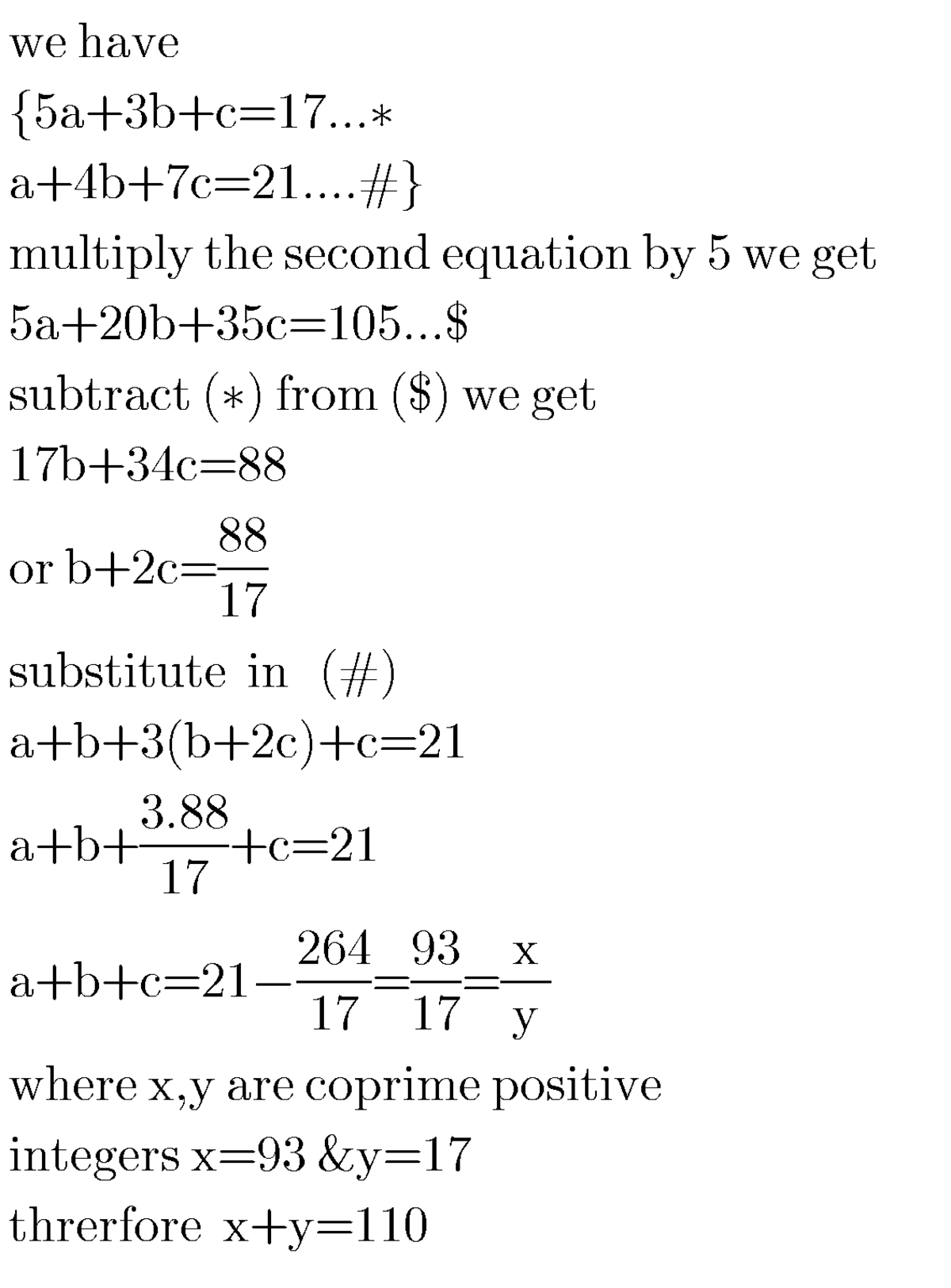Surprisingly Sufficient Information
⎩ ⎨ ⎧ 5 a + 3 b + c = 1 7 1 a + 4 b + 7 c = 2 1
Given that a , b and c satisfy the system of equations above, and a + b + c is equal to y x , where x and y are coprime positive integers, find x + y .
The answer is 110.
This section requires Javascript.
You are seeing this because something didn't load right. We suggest you, (a) try
refreshing the page, (b) enabling javascript if it is disabled on your browser and,
finally, (c)
loading the
non-javascript version of this page
. We're sorry about the hassle.
6 solutions
- Coefficients of first equation are in A.P with a common difference of (-2).
- Coefficients of second equation are also in A.P with a common difference of 3.
- Multiplying first equation by the absolute value of the Common difference of the second equation.
- Multiplying second equation by the absolute value of the Common difference of the first equation.
- We get,
- 1 5 a + 9 b + 3 c = 5 1
- 2 a + 8 b + 1 4 c = 4 2
- Adding both equations we get
- 1 7 a + 1 7 b + 1 7 c = 9 3
- a + b + c = 1 7 9 3
- So,
- 9 3 + 1 7 = 1 1 0
Moderator note:
Yes, the described system of steps work for this particular case. Tt would be better to explain why/when this would work in a more general setting.
Here is another good problem that you may try. https://brilliant.org/problems/who-gets-the-buck-2/ It has been qualified for level 2 algebra but the no. of solvers required is yet not met.
We multiply the first equation by m and the second equation by n to get { 5 m a + 3 m b + m c = 1 7 m n a + 4 n b + 7 n c = 2 1 n Adding these two equations yields ( 5 m + n ) a + ( 3 m + 4 n ) b + ( m + 7 n ) c = 1 7 m + 2 1 n We seek a value of m and n such that the above equation will be of the form 1 a + 1 b + 1 c = y x Comparison gives the equations ⎩ ⎪ ⎪ ⎪ ⎨ ⎪ ⎪ ⎪ ⎧ 5 m + n = 1 3 m + 4 n = 1 m + 7 n = 1 1 7 m + 2 1 n = y x Solving 5 m + n = 1 and 3 m + 4 n = 1 simultaneously, we get m = 1 7 3 , n = 1 7 2 To check if such combination is possible, we verify if this satisfies m + 7 n = 1 m + 7 n = 1 7 3 + 7 ⋅ 1 7 2 = 1 which checks. Therefore, the obtained values of m and n are what we desire. Hence, y x = 1 7 m + 2 1 n = 1 7 ⋅ 1 7 3 + 2 1 ⋅ 1 7 2 = 1 7 9 3 So, 9 3 + 1 7 = 1 1 0 .
This is a very useful method for solving this type of equations. In order to get an equation of the form a + b + c = y x , we must add up j times of the first equation and k times of the second equation.
Thus, we have 5 j + k = 3 j + 4 k = j + 7 k Solving, we have j = 1 . 5 k . Now, let k be any random integer (not 0) and j be the corresponding value. Multiply the first equation by j, the second equation by k and add them up. Then, the answer can be obtained.
Oh my ba god !!!!!! Your amazing. Thanks. Really helpful.
THE FOLLOWING IS AN OUTLINE
In a three variable equation with only two equations given, we can assume any one of the variables to be zero ( say c=0)
This reduces the problem to solving a two variable, two equation problem.
Solve.
If this method is correct, it works always. But the system with complete matrix of coefficients: [ 5 1 3 4 − 1 7 0 1 7 2 1 ] holds a sum that depends of c. For c=1, we obtain another result. So this method isn't the correct one.
I just made a+b+c=d be the third equation and solved for d (=x/y)
